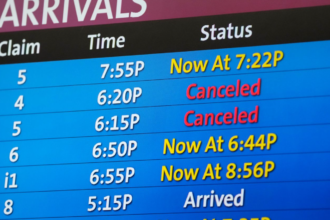Flight planning holds importance in airline pilot training and cannot be underestimated. It involves a process that includes determining the effective route, calculating fuel requirements, considering weather conditions, and ensuring compliance with regulations. An executed flight plan forms the basis for a seamless journey. Now, let’s explore further why flight planning is crucial in airline pilot training.
Evaluating Performance and Fuel Demands
One of the aspects of flight planning is evaluating aircraft performance during airline pilot training. It includes calculating fuel requirements. This assessment determines whether an aircraft can fly along a route while carrying fuel reserves to complete the journey safely.
While different aircraft may have varying capabilities, this evaluation generally involves considering factors such as weight restrictions, temperature variations, wind conditions, and fluctuations in air traffic. By considering these factors during flight planning, pilots can ensure their aircraft operates within limits while optimizing efficiency.
Comprehending Weather Charts and Reports
Weather conditions play a role in flight planning. To ensure smooth flights, it is crucial for pilots to properly assess weather reports, charts, and other meteorological resources. By doing so, they can anticipate any hazards or unfavorable conditions during their journey.
For aspiring airline pilots, it is important to develop an understanding of interpreting weather charts. For instance, METAR (Meteorological Aerodrome Reports) provides real-time observations about cloud coverage, wind speed, temperature dew points, visibility distances, and more. These observations directly influence decision-making during flight planning.
Likewise, TAF (Terminal Aerodrome Forecast) offers projections about the weather conditions at selected airports for up to 30 hours in advance. This information is essential for pilots as they develop strategies in their flight plans.
Compliance with Air Traffic Control Regulations
Since the USA needs more air traffic control staffing, ensuring compliance with air traffic control regulations is another aspect of flight planning during airline pilot training. Pilots must follow the procedures established by authorities to maintain safety standards and optimize communication with aircraft while avoiding congestion.
The International Civil Aviation Organization (ICAO) sets standards for aviation practices in order to promote uniformity and consistency throughout the industry. Additionally, each country has its authority to enforce national flight operation regulations. Pilots can ensure journeys while operating within boundaries by adhering to these regulations.
Maintenance and the Flight Plan
When we’re on a journey, it’s really important to monitor how the aircraft is performing to ensure efficiency and safety. Sometimes, unexpected weather conditions or air traffic congestion might cause deviations from the flight plan. In those situations, pilots need to make adjustments in time while considering their aircraft capabilities and following regulations.
Regular communication among pilots, air traffic control personnel, and airlines plays a role in optimizing routes when faced with weather changes or traffic slowdowns during the day of travel. This coordination also makes the flight journey productive and positive for all the parties involved.
The Role of Technology in Modern Flight Planning
In this age, technology has completely transformed how flight planning is done. We now have computer-based tools and software that make tasks like calculating routes, estimating fuel consumption, and creating navigation plans much simpler.
As part of their training, airline pilots often use Electronic Flight Bags (EFBs), which give them access to a range of information such as charts, wind forecasts at different altitudes, and GPS positioning features—allowing them to plan comprehensively even when offline with speed tables included.
Moreover, modern technology provides real-time information on hazards, like storms or restricted airspace areas. This helps pilots increase their awareness and make decisions when they need to adjust their plans mid-flight.
Conclusion
Flight planning is an aspect of airline pilot training. It allows pilots to analyze the capabilities of their aircraft, assess weather conditions, adhere to guidelines, and make informed decisions when it comes to modifying flight routes. By emphasizing the importance of flight planning throughout their training, aspiring pilots can pave the way for a successful career focused on ensuring efficient flights in the skies.














